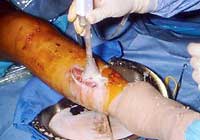Antibiotic solution no better than soap for open fracture irrigation
Randomized study found slight problems with wound healing with antibiotic irrigation solution.
A comparison of open fracture wound irrigation in the lower extremity found that antibiotics provided no added benefit over a soap solution. Antibiotics appeared to create wound healing problems, too.
 “Irrigation of open fractures is one of the most common
procedures that we perform in orthopedics and in traumatology, although the
parameters of the procedure have not been well studied in the literature.
Historically, a variety of irrigation additives have been used to clean open
wounds, including water, wine, milk, vinegar and turpentine. In current times,
probably the most common thing is antibiotics,� said Jeffrey Anglen, MD,
chairman of orthopedics at Indiana University.
“Irrigation of open fractures is one of the most common
procedures that we perform in orthopedics and in traumatology, although the
parameters of the procedure have not been well studied in the literature.
Historically, a variety of irrigation additives have been used to clean open
wounds, including water, wine, milk, vinegar and turpentine. In current times,
probably the most common thing is antibiotics,� said Jeffrey Anglen, MD,
chairman of orthopedics at Indiana University.
Anglen and colleagues began studying the differences between soap and antibiotics for wound irrigation after a student noted the foaming characteristics of antibiotic solution. They performed several lab and animal studies on varying solutions before beginning their clinical trial. He spoke at the American Academy of Orthopaedic Surgeons 72nd Annual Meeting.
|
COURTESY OF JEFFREY ANGLEN |
“We found that prior to the antibiotic era there were frequent recommendations in the literature and in surgical textbooks for the use of soap in open wounds, but this has been sort of lost as a part of standard teaching,� said Anglen, who was at the University of Missouri when this study was performed. He performed a prospective, randomized trial to determine if antibiotics held any advantages over soap for open fracture wound irrigation.
Anglen looked at three different outcomes: infection, delayed or nonunion and failure of wound healing. He enrolled 400 patients with 458 open fractures of the lower extremity. A total of 166 patients with 194 fractures in Group B received power wound irrigation with a Bacitracin solution, while 177 patients with 195 fractures in Group C were irrigated with Castile soap solution.
The groups had no significant differences in terms of tobacco use or multiple injury and ISS status. “There was a significant difference between the two groups, despite randomization, in mean age,� Anglen said. This was a four-year difference, and he also found significant differences in initial presentation with hypotension. “These differences are not explained. We don’t know why there would be any differences in spite of randomization, but we don’t think it affected the outcome.�
The fractures showed no difference across groups in terms of grade, location, loss of tissue, presence of vascular disruption or gross contamination. The treatments in the two groups were also the same, with similar injury-to-irrigation time and protocol deviations. Anglen did find a difference in duration of IV antibiotics. Group B, the Bacitracin group, showed an 18% infection rate, while Group C, the soap group, showed a 13% rate — not a significant difference.
For more information:
- Anglen J. A comparison of soap and antibiotic solution for irrigation of lower extremity open fracture wounds. #352. Presented at the American Academy of Orthopaedic Surgeons 72nd Annual Meeting. Feb. 23-27, 2005. Washington.

